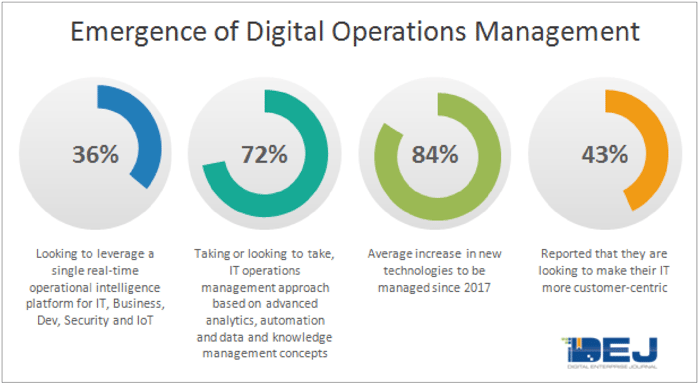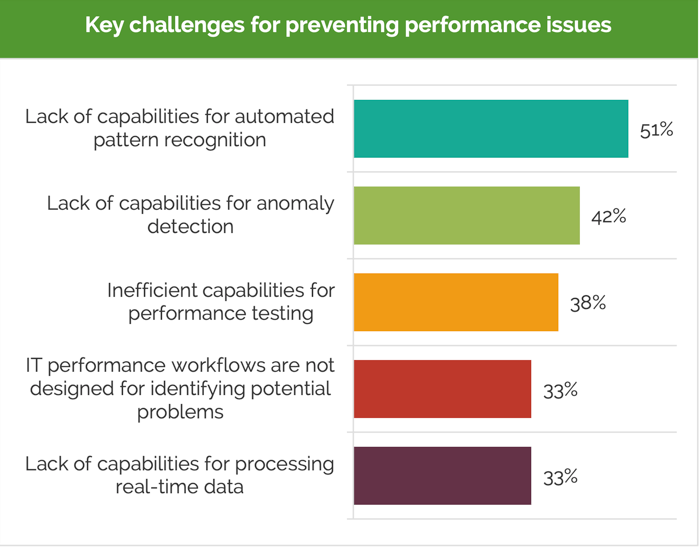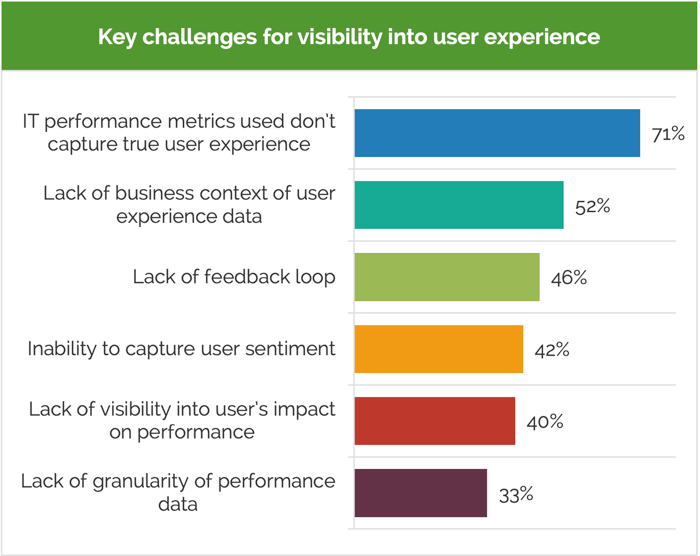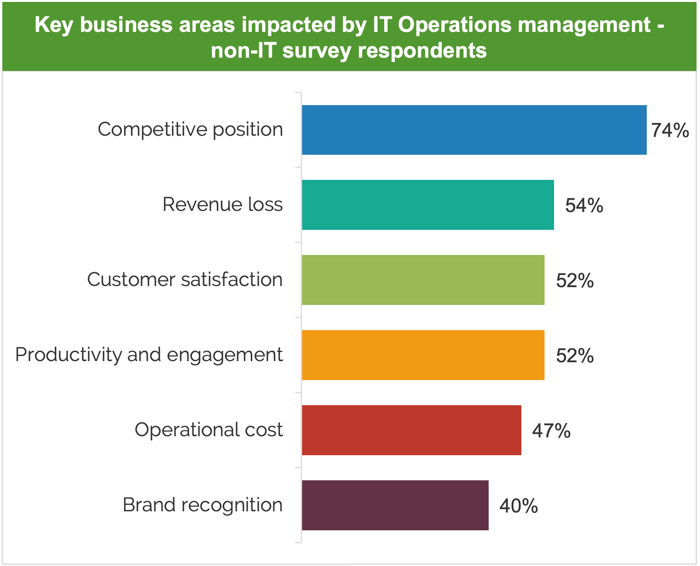Which Capabilities Ensure Superior IT Operations Performance?
Digital Enterprise Journal (DEJ) just released their latest market study, The Roadmap to Becoming a Top Performing Organization in Managing IT Operations. DEJ surveyed 900+ organizations to uncover the best practices and capabilities of the top 20% of IT operations teams. The thirty-three-page report uncovers how top performing IT organizations (TPOs) are reaping operational and business benefits in the form of:
- Agile Incident Management. TPOs can proactively detect 79% of performance issues ahead of time while all other organizations are only able to detect 39% of performance problems. The average mean time to incident resolution for TPOs is 38 minutes while it takes five times more time (224 minutes) for all other organizations.
- Faster Release Velocity with Lower Costs. TPOs can deliver innovative products and services at a faster pace (5.1 times faster release velocity as compared to all other organizations) and do so at a lower cost (4.2 times more end-users supported per IT full-time employees as compared to the rest of the cohort).

The DEJ report underlines four critical areas (platform thinking, intelligent event correlation, end-user experience monitoring, and business-IT alignment) that can help digital operations teams keep pace with change, exceed customer expectations, launch applications faster, and deploy technology as a source of competitive advantage.
#1 - Why Platform Thinking Matters
Given the volume, variety, and velocity of operational data that IT teams need to manage today, IT leaders will need to invest in a modern platform that can combine performance insights and deliver clear visibility into the health of IT services. 77% of top-performing organizations leverage an integrated platform for “unified analysis across their IT management tools stack.”

A digital operations management platform accelerates innovation and optimizes service delivery through:
- Hybrid Monitoring and Management. Given the rapid adoption of multi-cloud infrastructure, DevOps teams have turned to siloed tools for actionable performance insights into cloud-native services. However, multiple tools for hybrid monitoring can lead to “even more complexity to managing IT operations.” A digital operations management platform can help enterprises achieve a “44% average improvement in meeting SLAs” with the right levels of visibility, control, and governance.
- Eliminating Blind Spots. Nearly 40% of IT teams are using 10+ monitoring tools while 18% have 20+ monitoring tools in their organization. While point tools deliver deep insights for a specific domain (on-prem, cloud, or cloud native), a fragmented tools landscape can lead to ‘blind spots’ while troubleshooting business-critical services.
- Cross-Domain Insights. A platform-based approach to hybrid IT operations captures relevant data from different technology services and performance management tools, streamlines this data for a wide variety of use cases, and ensures that data is the foundation for the creation of new digital products and services.
- Organizational Collaboration. Enterprises need to embrace a “centralized, service-centric approach to managing IT performance” with an operational intelligence platform that caters to a diverse set of stakeholders, including IT operations, development, security, and the business.
#2 - How AIOps Reduces Human Time Spent on Incident Management
IT teams are combining machine learning techniques and data science methods for reducing event noise and gaining contextual insights for incident resolution. Top performing organizations are 2.1 times more likely to use automated processes for intelligent event correlation and 2.3 times more likely to use AIOps tools for rapid root cause(s) analysis.

An intelligent incident management solution can reduce constant firefighting and fix IT outages before there is any business impact through:
- Decreased Event Smog. The amount of events and alerts handled by IT operations teams has increased 2.7 times over the last two years. Service-centric AIOps helps incident managers pinpoint the root-cause(s) alerts that matter for faster issue recognition, impact analysis, problem isolation, and service restoration.
- Problem Prevention. While the average mean time to repair (MTTR) per incident is more than 3 hours, root cause(s) diagnosis consumes 72% of incident repair time. With organizations losing $126,000 for every hour of downtime, AIOps tools are vital for proactive issue detection before they become consequential incidents.
- Closed-Loop Incident Management. While anomaly detection and root cause(s) analysis are important AIOps capabilities, IT teams also need notification systems and automated remediation for delivering actionable insights to on-call teams and ensuring programmatic restoration without human intervention.
#3 - Digital Experience Monitoring for Compelling User Experiences
Delivering consistent levels of user experience and customer satisfaction is the holy grail of digital transformation. The DEJ report finds that more than two-thirds of IT organizations struggle to establish clear performance metrics that underpin the quality of end-user experiences.

Digital Experience Monitoring (DEM) solutions deliver actionable insights for supporting, streamlining, and enhancing digital customer experiences. Here is how DEM tools offer proactive insights and full visibility into end-to-end user experiences:
- Seamless Customer Experiences. Traditional IT operations metrics for infrastructure availability and performance are not a good proxy for customer interactions. DEM solutions let application owners measure the quality of user experiences with relevant metrics on “customer usage patterns, user impact on performance, user engagement, and business impact.”
- Customer-Centric Approaches. IT teams can drive revenue growth, customer intimacy, and competitive differentiation by focusing on internal and external customer experiences. DEM tools help enterprises manage an additional 4.2 users per IT employee, by improving user experiences across digital touchpoints, ensuring optimal customer journeys, and fixing performance issues across business transactions.
#4 - Driving Strategic Alignment between Business and IT Operations
The DEJ Roadmap study finds that only 26% of organizations can quantify the impact and contributions of IT operations to the organizational bottom line. How do IT operations leaders move from 'keeping the lights on' to growing and transforming the business?

IT teams will be increasingly measured by the contributions they make to conventional business metrics like revenue growth, profitability, time-to-market, and customer retention. IT operations teams will only be able to make this transformation through:
- Shifting Focus. IT operations will need to change from a systems management orientation that emphasizes low-level infrastructure health and performance to broader goal-based approaches that establish a clear connection between IT operations performance and tangible business outcomes.
- Contextual Data. The lack of business context in operational data limits the usefulness of such data for improving organizational performance. IT leaders will need to implement a balanced data strategy that puts the needs of business stakeholders first. Digital operations management platform can deliver contextual data that is “actionable, relevant, and aligned with business goals” for optimal decision making.
There’s much more in the thirty-three-page report, including the strategy, process, organization, and technology capabilities of top performing IT organizations. Download the DEJ report today to learn about the thirteen IT operations strategies employed by leading IT departments.
Next Steps:
- Check out the OpsRamp ROI Calculator.
- Follow OpsRamp on Twitter and LinkedIn for real-time updates and news from the world of IT operations.
- Schedule a custom demo with an OpsRamp solution expert.
![[Report] The Roadmap To Becoming a Top Performing IT Operations Organization](https://blog.opsramp.com/hubfs/Blog_images/DEJ%20blog/cover.png)





